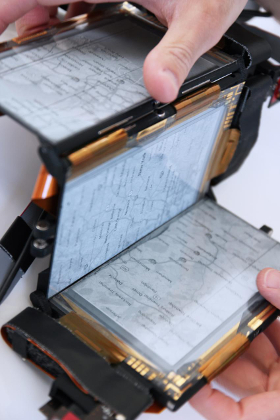Folding multi-screen could transform tomorrow's view
 Canadian engineers have shown off their early prototype for what could be an entirely new category of mobile device.
Canadian engineers have shown off their early prototype for what could be an entirely new category of mobile device.
Somewhere between an e-book, smartphone and laptop, the three-screen modular device combines a number of new technologies.
The instrument has been created to cover a lot of bases – it works as a handheld map, book, menu, phone, computer and almost any other form for rendering information.
Canada's Queen's University lab student Antonio Gomes along with Director, Roel Vertegaal have authored a paper on the creation that helps describe: “PaperFold: A Shape Changing Mobile Device with Multiple Reconfigurable Electrophoretic Magnetic Display Tiles.”
“Typically, mobile devices require scrolling or zooming in order to see different parts of a document whereas paper can be folded, detached or combined allowing it to be accessed in multiple parallel forms,” said the lab team's announcement.
“Books use folding as both a navigational and space saving technique, and paper maps have malleable display sizes,” says Dr. Roel Vertegaal, Professor of Human-Computer Interaction HCI at Queen's
“The PaperFold smartphone adopts folding techniques that makes paper so versatile, and employs them to change views or functionality of a smartphone, as well as alter its screen real estate in a flexible manner.
“PaperFold demonstrates how form could equal function in malleable mobile devices.
“In the near future, a computer will have any shape or form, and flexible computer displays will start appearing on any product of any form. These Organic User Interfaces will be completely embedded in real world interactions,” he said.
The team has created the following video to explain PaperFold’s many uses.







 Print
Print